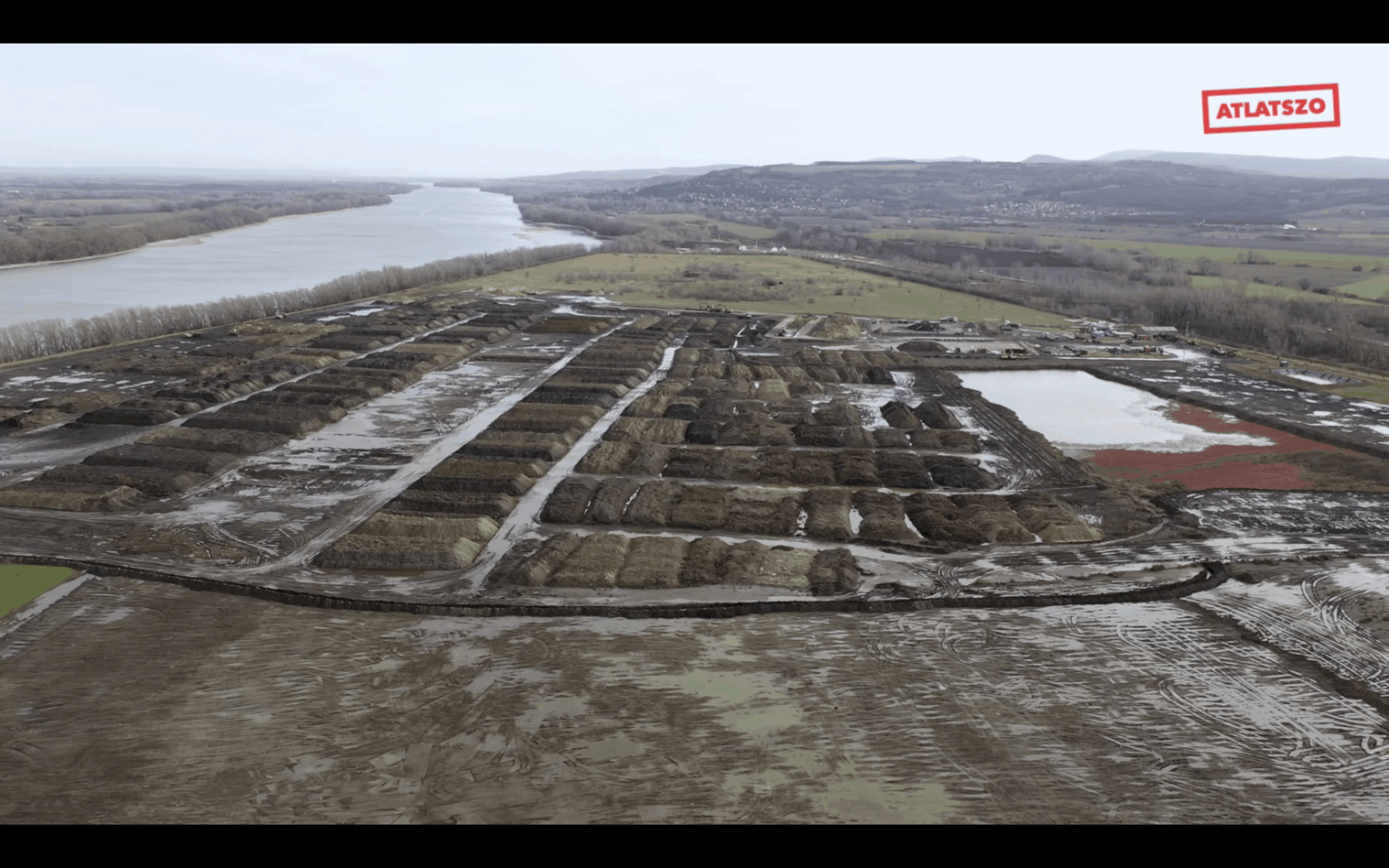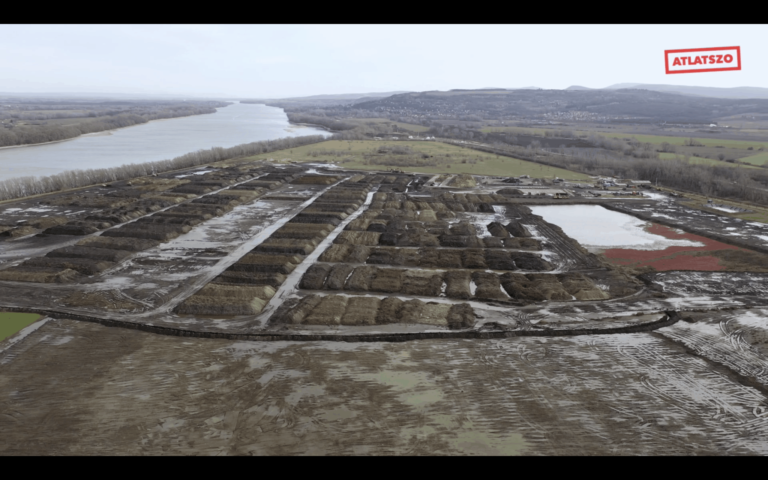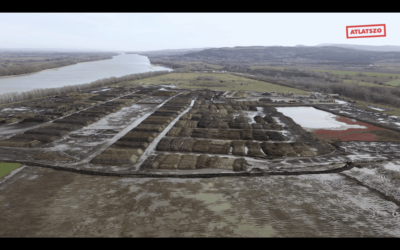In Almásfüzitő, a small factory settlement on the banks of the Danube, hazardous waste is being used to create a topsoil to cover solidified red sludge – residue from a long-closed alumina factory. Stored in large waste reservoirs, the largest of which is just a few hundred metres from locals’ homes, this residue from bauxite processing is separated from the Danube only by a permeable mud wall.
However, neither the state nor locals are up in arms. The company that manages the site, Tatai Environmental Protection Ltd. (TKV), has a valid permit and, for the most part, locals are annoyed at the attention the red mud reservoir attracts from environmentalists and media alike. Maybe, then, the standard way outsiders have looked at Almásfüzitő is wrong. What would it mean to see the settlement in a more positive light?
How about this?
Nestled on the banks of the Danube surrounded by lush vegetation, Almásfüzitő is home to state-of-the-art sports facilities, a kindergarten and primary school that are the envy of the region, a freshly renovated replica Roman camp, and a boat club. It has pretty much full employment, connections by road and train to nearby cities and Budapest, it boasts a well-maintained central square and now has a conscientious mayor who is developing the local infrastructure and has ambitious plans for the future.
Unlike many other post-industrial settlements that have failed to find their place in the last decades, Almásfüzitő is doing fine. Why then, should the settlement be defined by red mud and toxic waste?
The short answer is that it should not, but that does not make the ecological dangers disappear. We went to Almásfüzitő to find out why toxic waste could be deposited atop solidified red mud and what life was like living next to a hazardous waste site. What we found was the insidious subtle stranglehold of entwined pollution and corruption that has bled into so much of Hungarian politics, society and culture.
In Almásfüzitő it is not as simple as bags of cash passing hands in exchange for turning a blind eye. Moreover, it would be wrong to paint the situation in Almásfüzitő as just another story of oligarchs and Orbán’s anti-democratic tendencies, the frame most international press uses when writing about Hungary. Rather its how permits to process waste are drawn up, how the Hungarian state can protect illegal practices from the European Commission, how there are less and less reliable independent state apparatuses, how basic scientific facts are being abused, and how a local mayor has to balance resources to improve his locality.
Walking a Fine Line
Walking around Upper Almásfüzitő with the local mayor, László Beró is an education in enthusiasm. Mayor since 2017, after his predecessor was forced to step down, he won re-election unopposed as an independent candidate in 2019. Wearing his ‘I love Almásfüzitő’ t-shirt with unabashed pride, he switches between detailed explanations that reveal his school-teacher background and the expansive dreams of a mayor closer to the beginning than the end of his term. Like many of his generation he was born in the settlement after his parents moved to work in the alumina factory established in 1947, taking up residence in one of the newly built blocks of flats for the workers who arrived from all over Hungary.
As the mayor puts it, “Both professors and prostitutes were here; they came from Budapest when intellectuals also moved to Almásfüzitő. Only selected people could come here, with no criminal records, with an educational background. It wasn’t the case with the other part of the settlement. You see the differences. They were neglected.”
Almásfüzitő: kettészakadt település az egykori vörösiszap-tározó árnyékában from atlatszo.hu on Vimeo.
The ‘other part’ is Lower Almásfüzitő, twenty minutes’ walk downstream. Whereas Upper Almásfüzitő’s flats are now protected buildings, part of the country’s socialist architectural heritage, the lower part of the settlement – besides a couple of new state buildings – could be a poster boy for post-socialist post-industrial decline. This crumbling shabby part of the settlement never had its houses maintained by the alumina factory, but it is home to the still existing industrial activity: a sheet metal factory, an oil lubricants factory and the controversial waste treatment facility atop the red mud reservoir.
The divide between the upper and lower parts of the settlement is what comes forth first and foremost amongst locals in Lower Almásfüzitő when discussing politics and society, not the presence of red mud and toxic waste. As Alexandra Czeglédi, an anthropologist who spent months interviewing locals as part of our investigation pointed out, the division is “something very material that people can sense immediately in their everyday life, whereas the toxic waste is not necessarily sensed in the same way. There is a political tension that comes from this division, and people are more willing to describe this division, because they live through these separations.”
The division between the two parts of the settlement, on the one side, and the presence of a red mud site turned toxic waste ‘treatment’ facility in Lower Almásfüzitő on the other is linked, unsurprisingly, through money. The income from the industrial activity in the lower part of the settlement brings funding, both in tax revenue and through donations, for the benefit of all Almásfüzitő, yet the upper part is distanced from any immediate sense of environmental damage. This has historical roots, with locals remarking that even the design of Upper Almásfüzitő was done in a way as to protect it from pollution.
Locals in Upper Almásfüzitő further relied on the alumina factory to provide most of their material needs. As the mayor remembers, “Growing up here was wonderful!’ Minimal traffic, gardens, they even sponsored a volleyball team. Almost everything was free here: heating, water. The plumber was fixing everything for free. If you had any problems in your house, you would just call the company. And they came and fixed it. And that’s a problem now, as what a lot of people say to me is, ‘But we used to have it, Mr. Mayor’ and I say ‘yes, we used to!’”
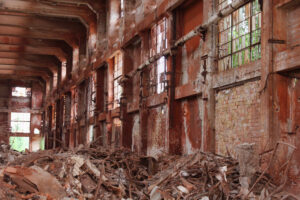
Long-closed alumina factory. Source: Atlatszo Foto
Whilst not being able to provide the same level of support as the alumina company once did, the mayor is able to improve infrastructure, develop tourism opportunities, and increase the wages of local council employees in a way that mayors in similarly sized settlements can only dream of. The decentralised Hungarian system of governance means that settlements, no matter how small, are responsible for not only providing, but also financing services that were previously covered by the central state or state-owned companies. The presence of the red mud toxic waste site, alongside the other industry, is a financial boon for Almásfüzitő because of the industrial tax paid to the local municipality. Meanwhile, the company which manages the red mud site, Tatai Environmental Protection Ltd. (TKV), further donates money for cultural and educational activities in the settlement.
And so here is the first bind that Almásfüzitő finds itself in: the more populous and historically more prosperous Upper Almásfüzitő materially benefits from the industrial and waste processing activities kilometres downstream, it is technically the same administrative unit. The situation has allowed the settlement to develop and grow after an extremely tough period in the 1990s. And, as the mayor points out, TKV has a permit, passes every check required and can show him that trees and tomatoes are now growing above the red mud. Who is he – and, indeed, who are we – to question the situation?
Governance Failures
Questions about Almásfüzitő remained for us, first of all, because of the way the environment is governed in Hungary. There is no ministry for the environment and no central environmental authority, with most permits related to environmental cases handled by the regional branches of the network of government offices. Many experts claim this does not guarantee an independent, professional administration of such cases.
The lack of adequate environmental institutions sits against the backdrop of the wider erosion of democratic structures. For years, journalists and international organisations regularly uncover how Prime Minister Orbán’s government has rigged the democratic system and try to remove the checks and balances which control the way money is spent and decisions are made.
Freedom of information issues are also raised in environmental matters with authorities often ignoring information requests from journalists, thus in many cases news outlets must rely on leaked information from whistle-blowers and sources who wish to keep their anonymity.
The European Union often expresses its concerns about the situation, citing corruption, human rights violations and lack of respect for democratic values, but its ability to act on its concerns appear ineffective.
This was the case, to some extent, with the infringement procedure the European Commission launched against Hungary in 2012 over the red mud reservoirs in Almásfüzitő. For years it seemed as if very little would happen as a result of this infringement case, even though the EC sent a group of experts to examine the site.
According to Gergely Simon, Regional Toxic Expert at Greenpeace Hungary, this can partly be explained through a shift in focus. Speaking to us in December 2019, he explained that, “Now the Commission goes for systemic problems. They don’t even start infringement cases for such issues as Almásfüzitő anymore. But since it’s obvious that it’s not in line with EU legislation, they cannot close the case. So, they’re really waiting for Hungary to issue the new permit, which was supposed to be coming out by 2015. But in the meantime, Hungary is ultimately afraid of giving a permit. It’s much easier for them to just play with the two different levels of authority. It’s a kind of endless story for us.”
Ownership Changes
The ‘endless story’ was given its momentum thanks to a ‘loophole’ in the original permit that allowed the site to continue operating even after the permit’s expiry in 2015. However, things seemed to suddenly move as rumours began to circulate that Hungary’s most successful businessman (some would rather use the term oligarch), Lőrinc Mészáros, a childhood friend of Prime Minister Viktor Orbán, was interested in purchasing the company operating the site.
The central argument by environmentalists has been that mixing hazardous waste with non-hazardous waste to form a topsoil above the red mud is scientifically unsound as it is not ‘treatment’ or ‘composting’, but rather dilution. Testing the topsoil for hazardous waste would show that the levels are within those permitted, but this does not mean that all the dangerous substances have been treated, but rather that they have been mixed together with large amounts of safe material.
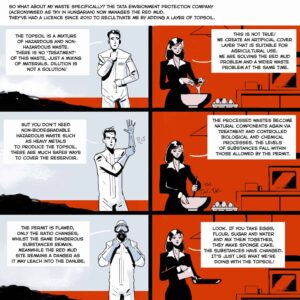
Source: Atlatszo
Pálma Paróczy, the Communication Coordinator at TKV, refuted this telling us that, “the recultivation work we carry out at our holding pond is waste recovery. The processed wastes become natural components again through appropriate treatment and controlled biological and chemical processes. The waste we use is degraded to the same materials that are found in natural soil. This technology is a widespread solution used by both domestic and international companies. The Government Office has stated that the processing used by Tatai Environmental Protection Co. is the best available technology of its kind.”
However, environmental scientists we spoke to as part of our investigation tell us that it contradicts extremely basic chemistry to suggest that some of the materials processed by TKV, such as heavy metals, can be ‘treated’ in this way as they are non-compostable.
The permit has been revised twice in the last months, first when the rumours began and then again with the eventual purchase of the site by a venture capital fund owned by the Mészáros Group. These permit changes ran parallel to some of our earlier reporting on the case and though the changes do not question the underlying premise of the controversial treatment process, they have significantly altered the permitted levels of hazardous materials.
The new long-term permit issued for the Almásfüzitő site was cautiously welcomed by Greenpeace as it prescribes stricter conditions, lower levels of hazardous components for the operation of TKV and thus, they conclude, is better for the environment.
However, Greenpeace stresses that it is to be seen whether the authorities will make sure the company complies with the new, stricter regulations concerning the content of hazardous substances in the materials shipped and deposited there.
The organisation also highlighted that the reservoir containing the solidified red mud is inadequately insulated and only separated from the river by a permeable earth dam. They stated that this still poses a huge ecological risk, as pollutants from the hazardous waste deposited there earlier could enter the Danube directly. Marta Vetier, the environmental scientist we worked with on the case, argues this can take place either through leaching of materials through the earth wall, or in case of any significant breach.
Whether it was increased media attention, Greenpeace’s campaigning, the new owner wishing to close the infringement proceedings, or a case of environmental enlightenment within the Hungarian government that led to the change in permits is unclear. It was equally unclear to us before we began anthropological research in the settlement, why more locals were not angry about the situation.
Apathy and Anger
Greenpeace are best known locally in Almásfüzitő for when they trespassed onto the site and wrote ‘STOP’ in large white letters onto the surface of the red mud reservoir so it could be seen from the sky. Many locals we spoke with were upset at their actions, claiming it created a ‘circus’, gave the settlement a bad name and made it impossible for those who wanted to sell their houses to leave. A subsequent video commissioned by Greenpeace referred to the closest street to the red mud reservoir as ‘Cancer Street’, claiming abnormally high cancer rates.
This upset many local inhabitants we spoke with, some of whom believed TKV rather than the environmental campaigners, but it also angered others who understood the argument against allowing hazardous waste onto the site, but were resigned to the situation and saw the environmentalists interventions as unhelpful and undertaken without the considerations of the locals.
Most locals would not speak on the record to journalists, but one 56-year old who had no such qualms was László, a grandfather, horse rider and, most recently, a local government representative. Living just a few hundred metres from the hazardous waste in Lower Almásfüzitő he has been vocal about the situation for years.
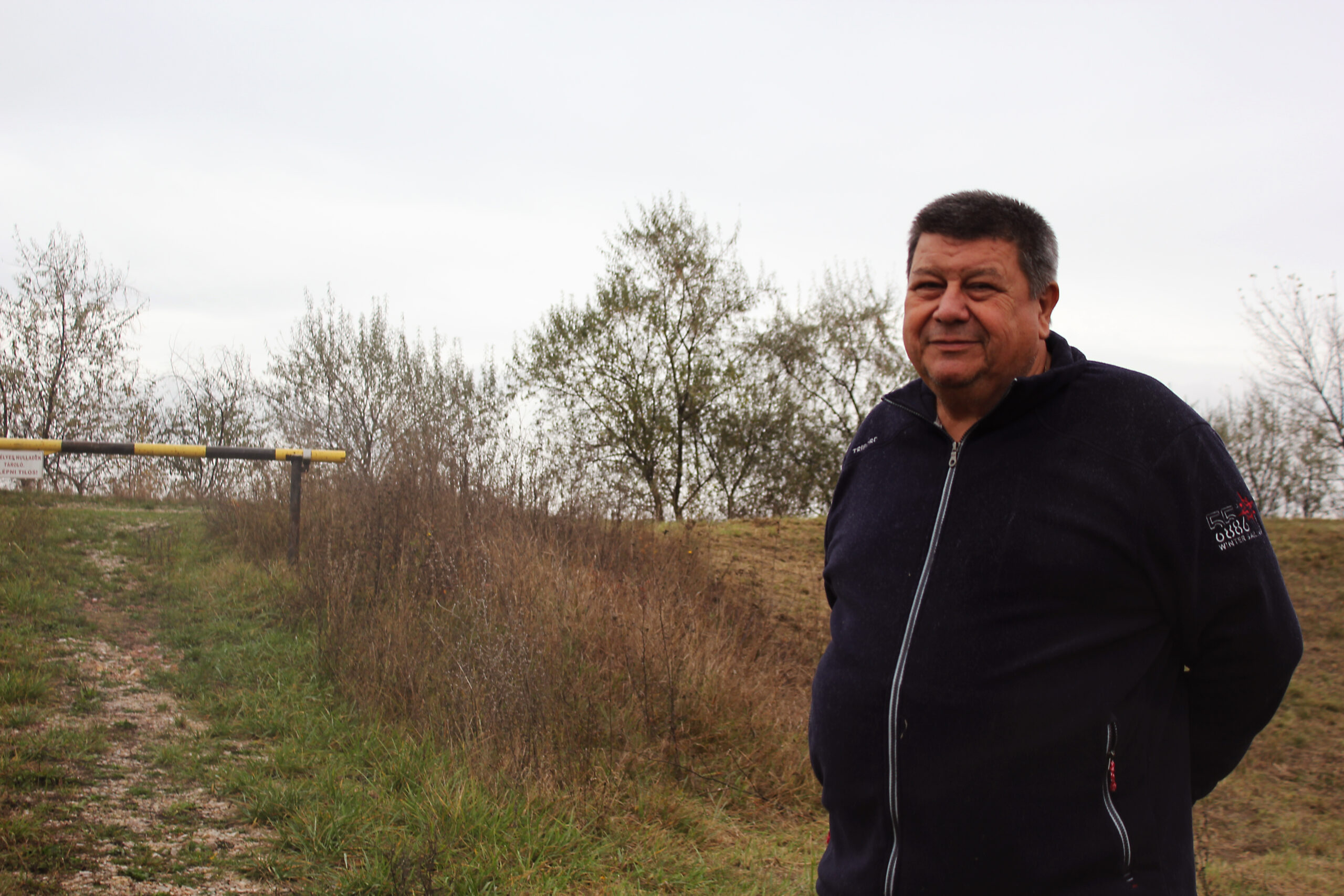
László lives just a few hundred metres from the hazardous waste in Lower Almásfüzitő. Source: Atlatszo Foto
However, he also understands that covering the red mud was needed and welcomed by all. This is why he finds it hard to convince his neighbours in the settlement to act about the contents used for the covering. He told us, “Now there is nowhere near as big a problem for them as when they found their clothes hanging on the washing line covered in red dust. Back then, if someone did not close the window when the wind started to blow, then everything inside their house was red.”
László claims to have seen waste dropped on the streets around the site and quickly cleared up; he says he’s spoken the drivers of lorries carrying waste directly from pharmaceutical companies; and he often complains of terrible smells wafting from the site, which he worries is endangering his baby grand daughter. TKV’s Communication Coordinator denies these claims, refused to reveal the companies depositing waste citing customer confidentiality, and pointed out that the smells are always investigated and could come from elsewhere.
According to the natural scientist we worked with on the story, what really ‘stinks’ about the case is that the covering work should have already been completed but continues. There seems to be no obvious reason for this, beyond keeping the possibility alive to keep bringing hazardous waste to the site. Pálma Paróczy, TKV’s Communication Coordinator suggests this is because they do not have enough materials to finish the topsoil application, stating “the amount of industrial waste has decreased in recent years due to the modernization of production technologies and tougher environmental regulations. Despite the current downward trends, the covering work of Reservoir № VII is expected to be completed in the early 2020s.”
However, this still does not explain why the second layer is being added to the reservoir. We wanted to look for ourselves, and László decided the best way for us to understand the problem was to march us through the back of his garden, and show us the waste site itself.
Without being granted a tour during which we could ask questions, we can only speculate on what we could see from afar and from drone footage of the operations gathered by Hungarian investigative news site Atlatszo. However, according to Marta Vetier, the expert environmental scientist we worked with on the case it would be possible to cover the remaining section of the reservoir with inert non-hazardous wastes in a really short amount of time to stop the red mud dust being blown away. She also questioned the seemingly insufficient rainwater drainage and the fact that the site is on the banks of the Danube and no kinds of wastes should be treated or deposited next to a river.
For their part, TKV Communication Coordinator stated to us that, “Waste may only be delivered to the site in a previously agreed and controlled manner. The major, recoverable part of any such waste is recycled with our technology, while some packaging materials or other waste not suitable for our recycling process are passed to authorized companies specialized in the management of such waste.”
On the day László took us onto the site he got into an altercation with a guard once we had already left TKV’s property. He put the guard in his place with the full authority of a proud and confident man, but also with the frustration of someone who feels the many layers of power stacked against him. He can win the small fights, but the bigger question of how he lives his life next to hazardous waste remains.
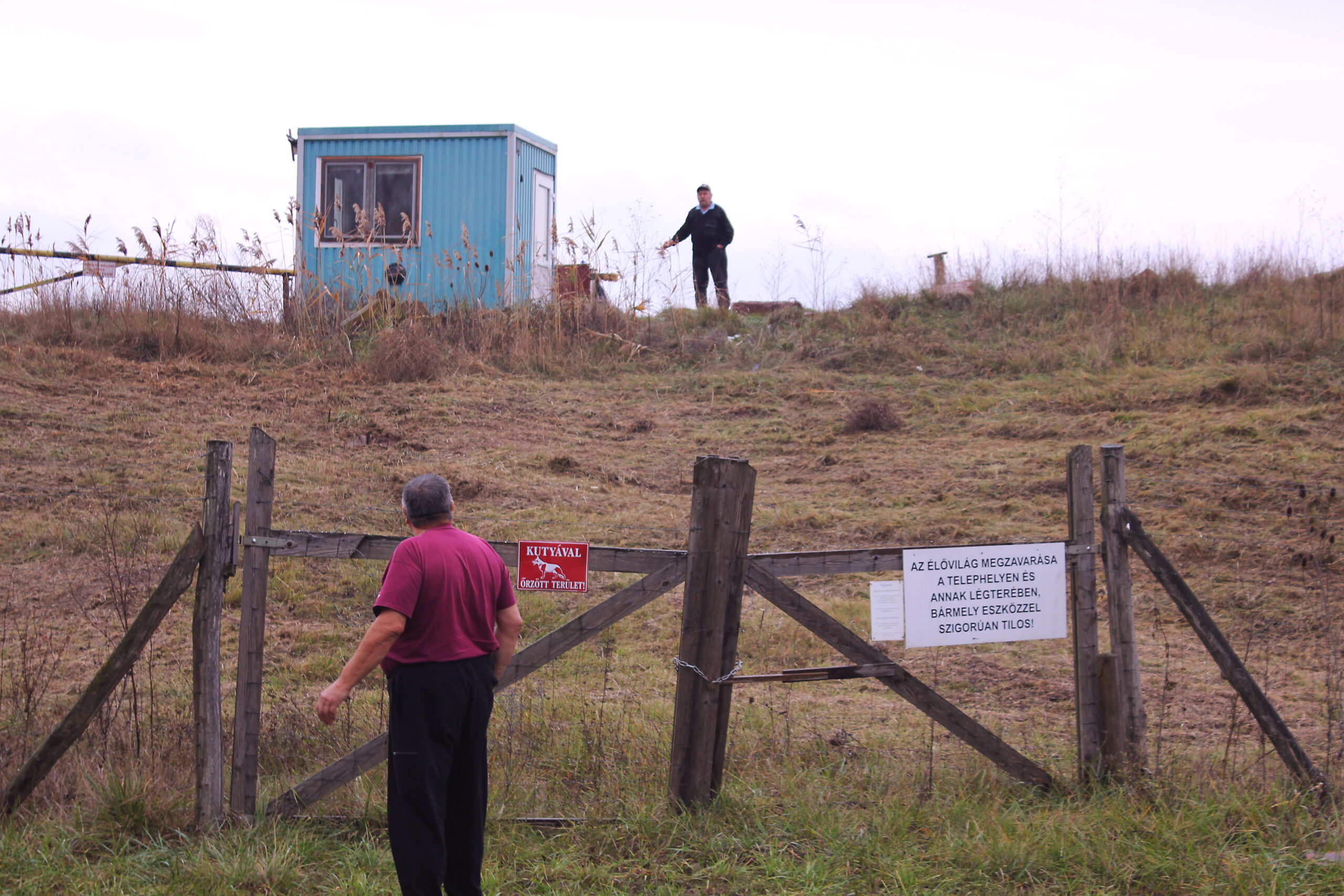
László with a guard near TKV’s property. Source: Atlatszo Foto
A few months earlier he told us that even though, unlike others, he is not scared to speak out and speak up, he also recognises that on some level he has little choice but to accept the situation. As long as the divide between the two parts of the settlement remains, those who live in the smaller, poorer part of the settlement close to the red mud reservoir will struggle to affect political change. As he told us with a wry grin, “here’s the reservoir, over there is happiness.”
The Future as Red
Of course, such challenges do not only relate to the environment, with architectural heritage facing similar issues of unchecked economic growth and ineffective control mechanisms. Nor is environmental mismanagement unique to Hungary.
But what is clear, is that despite the growing interest in the environment amongst the public and the increased ability for campaigners to raise concerns through social media, such campaigns struggle to address the political structures, material concerns and socio-cultural contexts of how and why toxic waste can be placed above red mud in an uninsulated reservoir on the banks of one of Europe’s most important rivers.
This article is the result of the cooperation of academic researchers and journalists in the project titled Black Waters at the Center for Media, Data and Society within CEU’s School of Public Policy. The aim of this project – supported by the Open Society Initiative for Europe – is to call the attention to environmental problems, corruption and the social consequences of these in Central and Eastern Europe.
Related stories on Atlatszo.hu:
Almásfüzitő: a divided settlement in the shadow of the former red mud reservoir
Hazardous waste deposit at the red sludge reservoirs in Almásfüzitő was issued a new permit
The Life and Times of Red Mud Reservoir № VII
In Hungary, environmental protection is crippled so as not to hinder economic development
Mészáros Group acquires lucrative toxic waste processing site after the state renewed its permit
Hazardous waste deposited in red sludge reservoirs

